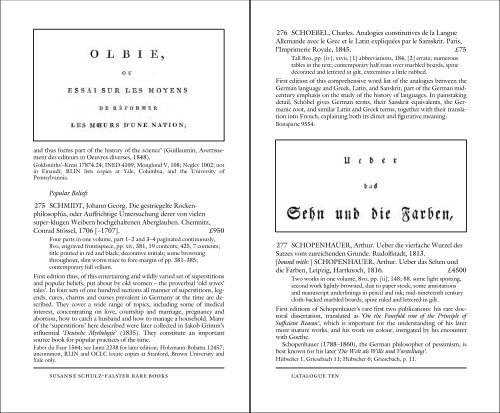Susanne Schulz-Falster Catalogue Ten - Schulz-Falster Rare Books
Susanne Schulz-Falster Catalogue Ten - Schulz-Falster Rare Books
Susanne Schulz-Falster Catalogue Ten - Schulz-Falster Rare Books
Create successful ePaper yourself
Turn your PDF publications into a flip-book with our unique Google optimized e-Paper software.
and thus forms part of the history of the science’ (Guillaumin, Avertissement<br />
des editeurs in Oeuvres diverses, 1848).<br />
Goldsmiths’–Kress 17874.24; INED 4109; Monglond V, 108; Negley 1002; not<br />
in Einaudi; RLIN lists copies at Yale, Columbia, and the University of<br />
Pennsylvannia.<br />
Popular Beliefs<br />
275 SCHMIDT, Johann Georg. Die gestriegelte Rockenphilosophia,<br />
oder AuVrichtige Untersuchung derer von vielen<br />
super-klugen Weibern hochgehaltenen Aberglauben. Chemnitz,<br />
Conrad Stössel, 1706 [–1707]. £950<br />
Four parts in one volume, part 1–2 and 3–4 paginated continuously,<br />
8vo, engraved frontispiece, pp. xiv, 381, 19 contents; 425, 7 contents;<br />
title printed in red and black; decorative initials; some browning<br />
throughout, slim worm trace to fore-margin of pp. 381–385;<br />
contemporary full vellum.<br />
First edition thus, of this entertaining and wildly varied set of superstitions<br />
and popular beliefs, put about by old women – the proverbial ‘old wives’<br />
tales’. In four sets of one hundred sections all manner of superstitions, legends,<br />
cures, charms and curses prevalent in Germany at the time are described.<br />
They cover a wide range of topics, including some of medical<br />
interest, concentrating on love, courtship and marriage, pregnancy and<br />
abortion, how to catch a husband and how to manage a household. Many<br />
of the ‘superstitions’ here described were later collected in Jakob Grimm’s<br />
inXuential ‘Deutsche Mythologie’ (1835). They constitute an important<br />
source book for popular practices of the time.<br />
Faber du Faur 1564; see Jantz 2238 for later edition; Holzmann-Bohatta 12457;<br />
uncommon, RLIN and OCLC locate copies at Stanford, Brown University and<br />
Yale only.<br />
susanne schulz-falster rare books catalogue ten<br />
276 SCHOEBEL, Charles. Analogies constitutives de la Langue<br />
Allemande avec le Grec et le Latin expliquées par le Samskrit. Paris,<br />
l’Imprimerie Royale, 1845. £75<br />
Tall 8vo, pp. [iv], xxvii, [1] abbreviations, 184, [2] errata; numerous<br />
tables in the text; contemporary half roan over marbled boards, spine<br />
decorated and lettered in gilt, extremities a little rubbed.<br />
First edition of this comprehensive word list of the analogies between the<br />
German language and Greek, Latin, and Sanskrit, part of the German midcentury<br />
emphasis on the study of the history of languages. In painstaking<br />
detail, Schöbel gives German terms, their Sanskrit equivalents, the Germanic<br />
root, and similar Latin and Greek terms, together with their translation<br />
into French, explaining both its direct and Wgurative meaning.<br />
Bonaparte 9554.<br />
277 SCHOPENHAUER, Arthur. Ueber die vierfache Wurzel des<br />
Satzes vom zureichenden Grunde. Rudolfstadt, 1813.<br />
[bound with:] SCHOPENHAUER, Arthur. Ueber das Sehen und<br />
die Farben, Leipzig, Hartknoch, 1816. £4500<br />
Two works in one volume, 8vo, pp. [ii], 148; 88. some light spotting,<br />
second work lightly browned, due to paper stock; some annotations<br />
and manuscript underlinings in pencil and ink; mid-nineteenth century<br />
cloth-backed marbled boards, spine ruled and lettered in gilt.<br />
First editions of Schopenhauer’s rare Wrst two publications: his rare doctoral<br />
dissertation, translated as ‘On the Fourfold root of the Principle of<br />
SuYcient Reason’, which is important for the understanding of his later<br />
more mature works, and his work on colour, instigated by his encounter<br />
with Goethe.<br />
Schopenhauer (1788–1860), the German philosopher of pessimism, is<br />
best known for his later ‘Die Welt als Wille und Vorstellung’.<br />
Hübscher 1, Griesebach 11; Hübscher 6; Griesebach, p. 11.
















